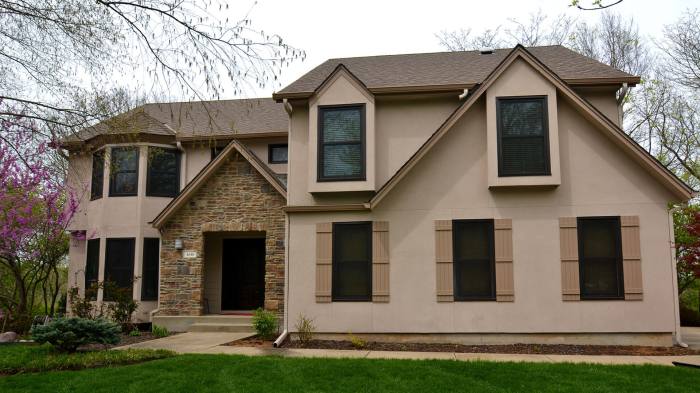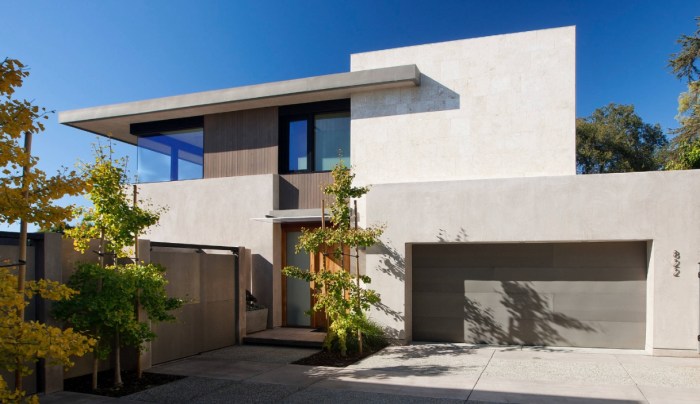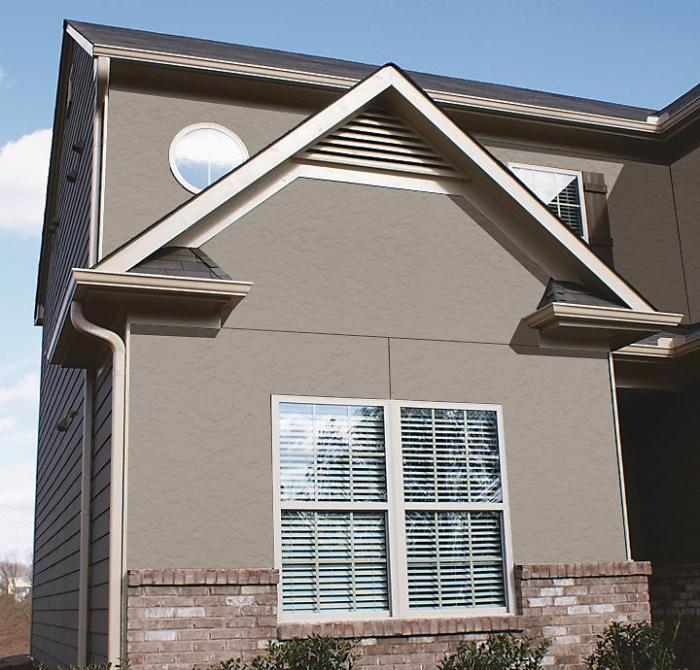Exploring the Beauty of Smooth Stucco Siding
As smooth stucco siding emerges as a key player in architectural design, this introduction invites readers into a realm where aesthetics meet functionality, promising an enriching and unique exploration.
The following paragraphs will delve into the intricacies of smooth stucco siding, shedding light on its characteristics and diverse applications.
Introduction to Smooth Stucco Siding

Smooth stucco siding is a popular exterior finish for buildings, characterized by its sleek and seamless appearance. This type of siding is made from a mixture of cement, sand, and water, creating a smooth and uniform surface when applied to the exterior walls of a structure.
Benefits of Smooth Stucco Siding
- Durability:Smooth stucco siding is known for its durability and long lifespan, providing excellent protection against harsh weather conditions.
- Low Maintenance:Once applied, smooth stucco siding requires minimal maintenance, saving both time and money for property owners.
- Energy Efficiency:The insulating properties of smooth stucco siding can help improve the energy efficiency of a building, reducing heating and cooling costs.
- Versatility:Smooth stucco siding comes in a variety of colors and can be textured to achieve different looks, making it a versatile choice for modern architectural designs.
Popularity in Modern Architecture
Smooth stucco siding has gained popularity in modern architecture due to its clean and contemporary aesthetic appeal. Architects and designers often choose smooth stucco siding for its ability to create a seamless and minimalist look, enhancing the overall design of the building.
Additionally, the customizable nature of smooth stucco siding allows for creative freedom in architectural expression, making it a favored choice in contemporary construction projects.
Installation Process

When it comes to installing smooth stucco siding, there are several key steps involved to ensure a successful and durable outcome. Let's dive into the details of the installation process and compare it to other siding materials.
Preparation
Before starting the installation process, it is crucial to prepare the surface properly. This involves cleaning the existing surface, repairing any damage, and applying a bonding agent to ensure the stucco adheres correctly.
- Remove any existing siding or finish to expose the bare surface.
- Inspect the surface for any cracks, holes, or damage that need to be repaired before proceeding.
- Apply a bonding agent to promote adhesion between the stucco and the surface.
Application of Stucco
The next step involves applying the stucco mixture to the prepared surface. This can be done using a trowel or sprayer, depending on the desired finish and texture.
- Prepare the stucco mixture according to the manufacturer's instructions, ensuring the right consistency for application.
- Apply the stucco evenly and smoothly, working in small sections to prevent drying before finishing.
- Use a trowel to create the desired texture or finish, such as smooth, swirled, or textured.
Curing and Finishing
Once the stucco is applied, it needs time to cure and set properly. This process is crucial for the stucco to harden and become durable over time. It is essential to protect the stucco from moisture during this curing period.
- Allow the stucco to cure for the recommended time, typically a few days to a week, depending on the weather conditions.
- Protect the stucco from rain or excessive moisture during the curing process to prevent damage.
- Once the stucco is fully cured, you can apply a sealant or paint to enhance its durability and appearance.
Comparison to Other Siding Materials
Compared to other siding materials like vinyl or wood, smooth stucco siding offers a unique texture and finish that can enhance the overall aesthetic of a building. However, the installation process for smooth stucco may require more skill and precision due to the application and finishing techniques involved.
Tips for a Smooth and Durable Installation
To ensure a successful installation of smooth stucco siding, consider the following tips:
- Follow the manufacturer's instructions carefully when preparing and applying the stucco mixture.
- Work in small sections to maintain consistency and prevent drying before finishing.
- Use high-quality materials and tools to achieve a professional-looking finish.
- Protect the stucco from moisture during the curing process to prevent damage and ensure durability.
Maintenance and Care
Smooth stucco siding, like any exterior surface, requires regular maintenance to ensure its longevity and appearance. Proper care will not only enhance the curb appeal of your home but also prevent potential damage.
Cleaning and Upkeep
Regularly cleaning smooth stucco siding is essential to prevent the buildup of dirt, mold, and mildew. Here are some effective cleaning methods:
- Use a mixture of mild detergent and water to gently scrub the surface with a soft-bristled brush.
- Rinse thoroughly with a garden hose to remove any residue.
- Avoid using high-pressure washers, as they can damage the stucco surface.
Common Issues and Solutions
Despite its durability, smooth stucco siding may encounter some common issues over time. Here are a few problems you may face and how to address them:
- Cracks:Small cracks can develop due to settling or extreme weather conditions. Fill them with a quality stucco patching compound and repaint if necessary.
- Staining:Stains from algae or water runoff can occur. Use a mixture of bleach and water to remove stains, followed by a thorough rinse.
- Mold and Mildew:To prevent mold and mildew growth, ensure proper ventilation and address any water leaks promptly. Clean affected areas with a solution of water and white vinegar.
Design Options and Customization
When it comes to smooth stucco siding, there are various design options and customization possibilities available to enhance the aesthetic appeal of your property. Let's explore some of these options below.
Color Variety
One of the key design elements of smooth stucco siding is the wide range of colors available. From earthy tones to vibrant hues, homeowners can choose a color that complements their architectural style and personal preference. Lighter colors can make a property appear larger, while darker shades can add a touch of sophistication.
Texture and Finish
In addition to color, the texture and finish of smooth stucco siding can be customized to achieve different looks. Whether you prefer a smooth and sleek finish or a textured appearance, there are options to suit every taste. Some homeowners opt for a polished finish for a modern look, while others choose a more rustic texture for a traditional feel.
Architectural Accents
Smooth stucco siding can also be used to create architectural accents and details on a property. From decorative trim and moldings to unique shapes and patterns, the possibilities for customization are endless. These accents can help add character and charm to a home, making it stand out in the neighborhood.
Integrated Features
Another way to customize smooth stucco siding is by integrating features such as lighting fixtures, planters, or even artwork directly into the siding. This seamless integration can create a cohesive and visually appealing look that sets your property apart from the rest.
Examples of Innovative Designs
Innovative designers and architects have used smooth stucco siding in creative ways to achieve stunning results. For example, combining smooth stucco with other materials like wood or metal can create a striking contrast and a unique aesthetic. Additionally, playing with shapes and angles can result in a visually dynamic exterior that catches the eye.By exploring the various design options and customization possibilities for smooth stucco siding, homeowners can create a personalized and visually appealing exterior that reflects their style and enhances the overall look of their property.
Final Review

In conclusion, smooth stucco siding offers a blend of elegance and durability, making it a top choice for modern structures seeking a touch of sophistication. Dive into the world of smooth stucco siding and elevate your architectural vision today.
Q&A
How long does smooth stucco siding last?
Smooth stucco siding can last for decades if properly maintained, typically requiring repainting every 5-10 years.
Can smooth stucco siding be painted?
Yes, smooth stucco siding can be painted to change or refresh its appearance, offering versatility in design options.
Is smooth stucco siding prone to cracking?
While smooth stucco siding is durable, it may develop hairline cracks over time due to settling or environmental factors. These can be easily repaired.
What climates are suitable for smooth stucco siding?
Smooth stucco siding is versatile and can withstand various climates, but it performs best in dry or moderate climates with minimal exposure to extreme moisture.




